San Mamés
| Capacity | 53 000 |
|---|---|
| 192 (Tribune of honor) | |
| 508 (VIP seats) | |
| 2,352 (Business seats) | |
| 162 (Press seats) | |
| 260+260 (Disabled seats) | |
| Country | Spain |
| City | Bilbao |
| Clubs | Athletic Club de Bilbao |
| Inauguration | 16/09/2013 (Athletic Bilbao - Celta Vigo, 3-2) |
| Construction | 05/2010 - 09/2014 |
| Renovations | 2016 |
| Cost | € 211 million |
| Record attendance | 49,164 (Athletic Bilbao - Real Madrid, 18/03/2017) |
| Design | Idom |
| Contractor | INBISA |
| Address | Rafael Moreno Pitxitxi Kalea s/n, 48013 Bilbao, Bizkaia, Espana |
Advertisement
San Mamés – stadium description
Why was San Mamés built?
Athletic Club played for most of its history at the old San Mamés stadium, which had been modernized several times since its opening in 1913. The last major renovation took place in 1982 for the FIFA World Cup. However, by the 1990s, plans for a new stadium began to emerge because the old one was becoming outdated, with insufficient safety measures and accessibility. Additionally, UEFA started implementing stricter regulations, such as eliminating standing terraces and improving access for people with disabilities.
In the 1990s, Bilbao authorities began urban modernization projects, during which Spanish architect Santiago Calatrava proposed building a new football stadium at this location with a preliminary design. This proposal was rejected since city officials did not want a stadium in that part of the city. Another proposal came from Norman Foster, a famous British architect, who designed a 55,000-seat stadium with a shopping center and office building under the stands, planned on the site of a former market. This project also failed due to architectural issues.
In the early 2000s, the then club president Javier Uría seriously considered building a new stadium on the former market grounds. Studies and feasibility analyses were conducted. The initial design was presented to club members, who approved it, starting the process that led to the new stadium.
How was San Mamés constructed?
In 2004, Athletic Club’s board started work on the new San Mamés stadium. The location was the old market hall area in Bilbao, which lost importance after the construction of the BEC (Bizkaia Exhibition Center). In 2006, the city changed the zoning plan to reserve space for the new stadium. The stadium was planned to hold 50–55,000 spectators and cover a larger area than its predecessor.
In 2007, the San Mamés Barria company was formed, including Athletic Club, BBK, and the Bizkaia Provincial Council. That year, César Azkarate’s project was presented, featuring a modern stadium with a lit glass facade and a capacity of 56,000. The design was approved by socios (club members).
Due to the 2008 economic crisis, the project was simplified: some stands and the glass facade were removed, reducing capacity to 53,000. Despite controversies, construction began in 2010, with the first phase completed in summer 2013.
When was San Mamés inaugurated?
San Mamés officially opened on September 16, 2013, at 10:00 PM during the fourth round match of the 2013/14 La Liga season, where Athletic Club faced RC Celta de Vigo. About ten minutes before kickoff, a ceremony took place: club president Josu Urrutia entered the pitch accompanied by captains of all Athletic teams, led by Carlos Gurpegui and Iraia Iturregi, welcomed with applause by both teams. The youngest captain placed a piece of turf from the old stadium at the center circle and received a commemorative plaque. Then, everyone moved to the tunnel for an honorary aurresku dance. Urrutia also laid flowers at the bust of the legendary Rafael Moreno Pichichi.
The ceremony ended with a joint raising of the Athletic flag on a mast at the corner of the south stand, which was partially unfinished; the last to raise the flag was Carlos Gurpegui.
The first goal in the new stadium was scored by Celta’s Charles Dias in the 14th minute. Athletic equalized through Mikel San José, and in the second half, Andoni Iraola and Beñat Etxebarria scored, giving the hosts a 3–1 lead. Santi Mina scored for Celta making it 3–2, but Athletic won the match.
Full stadium capacity was officially available by summer 2014 before the UEFA Champions League match against SSC Napoli, though some works were still unfinished.
What does San Mamés look like?
San Mamés was designed to preserve and enhance the distinctive sound atmosphere created by the local fans’ chants. Externally, it has a classic football stadium look but hides much more than just stands. Beneath it are extensive facilities covering 5,434 m², co-funded by the Basque Government. These do not affect the exterior or significantly raise costs as they are invisible from the street.

The underground area hosts a modern municipal sports complex opened in 2019, featuring exercise rooms, a sauna, Turkish bath, spa, and two swimming pools—one Olympic-sized and one for children. It also includes an athletics module with a 60-meter track and equipment for jumps and throws, though the original plan for a full-size track was abandoned. San Mamés also houses a Sports Innovation Center and a Sports Medicine Center supporting athlete development. The stadium includes four locker rooms, 40 offices, 48 VIP boxes, a club museum by gate 20, an official store, a high-end restaurant, an external LED screen, a sports bar, and a traditional tavern overlooking the pitch.

The external look is complemented by an advanced façade lighting system, which can program the illumination of hundreds of white panels to shine uniformly or display dynamic graphics, such as after a goal or UEFA Champions League star motifs—similar to Munich’s Allianz Arena. The stadium is situated closer to the Nervión River on a high bank, giving it an impressive, picturesque character, especially visible at night when lit.
Since 2015, a large external video screen (15.5 x 9.8 m) is located where the club’s old crest once was, facing Pozas Street—a popular walk route with bars frequented by Athletic fans. In 2019, special safe-standing barriers were installed in the north stand and expanded in 2022 to the entire lower sector, creating a singing fans sector.
In 2023, during the club’s 125th anniversary, subtle lines marking the old pitch’s goal lines and a monument to club appearance record-holder José Ángel Iribar were unveiled.
What problems did San Mamés have and how were they solved?
Problems mainly concerned insufficient protection from rain during matches, which fans often complained about. To solve this, Athletic Bilbao decided to expand the stadium roof to cover a larger area, improving shelter for spectators. Work began in May 2016, and the new larger roof was completed by autumn that year. The project, fully financed by the club at a cost of about €13 million, won an engineering award in 2017. This effectively addressed the rain issue, enhancing fan comfort.
What is San Mamés used for?
San Mamés primarily serves as Athletic Bilbao’s home football stadium, hosting league and cup matches. It also functions as a sports and recreational center, offering facilities like the municipal sports complex with gyms, sauna, spa, pools, and innovation and sports medicine centers. It hosts cultural events, concerts, and sports other than football, such as rugby finals. The stadium is a community hub integrating sport, culture, and recreation.
What sporting events have taken place at San Mamés?
The stadium has hosted numerous league, cup, and international matches for both men’s and women’s Athletic teams. In May 2018, it hosted the European rugby finals—EPCR Challenge Cup and Investec Champions Cup—and will again host them in 2026. It was also the start location for stages of the Spanish cycling race La Vuelta a España in 2019 and 2022. Although planned as a UEFA Euro 2020 venue, Bilbao lost hosting rights due to COVID-19 pandemic restrictions.
What non-sporting events have taken place at San Mamés?
San Mamés has hosted concerts by famous artists and bands such as Guns N’ Roses, Metallica, and Fito & Fitipaldis, attracting thousands of spectators. Thanks to modern infrastructure and excellent acoustics, it is popular for large musical and cultural events. The stadium also offers restaurants, sports bars, and other amenities that support social and community events, making it a gathering place for sports and culture fans alike.
What awards has San Mamés received?
San Mamés has received numerous prestigious awards. In 2015, the new San Mamés took second place in the global Stadium of the Year poll, organized at the time by StadiumDB.com and Stadiony.net. The vote reached a record scale – over 96,000 people from 136 countries participated, awarding points to their five favourite stadiums opened that year. San Mamés received more than 96,000 points, finishing just behind Allianz Parque in São Paulo. Also in 2015, it was named the world’s best sports building at the World Architecture Festival. It was the first stadium in Europe to obtain the LEED sustainable building certification. The roof construction by Inbisa Construcción won the best facade and roof structure award at the third Ache engineering awards.
In 2017, it was recognized as the safest stadium in Europe, receiving the UNE 179.003 patient safety certificate from DNV GL, renewed in 2019. That same year, it was chosen as the world’s best stadium at the World Football Summit in Madrid. The roof, designed by Idom, won the international Structural Awards in the Grandes Luces
category for outstanding structural engineering projects. In 2020, it ranked ninth on France Football’s list of the world’s 30 most vibrant stadiums and won the World Design Awards for sports and recreational facilities. On January 30, 2019, San Mamés set a Spanish attendance record for a women’s match, gathering 48,121 fans during the Copa de la Reina quarterfinal between Athletic Club and Atlético de Madrid, which was also the second-highest worldwide attendance for such competitions.
How San Mamés compares to other LaLiga stadiums?
Advertisement
Pictures

2016 © INBISA 
28.07.2019 © Jaime Silva (cc: by-nc-nd) 
03.05.2019 © Harri Schultz 
02.11.2017 © groundhopping.se 
2016 © Athletic Club 
2016 © INBISA 
03.05.2019 © Harri Schultz 
03.05.2019 © Harri Schultz 
03.05.2019 © Harri Schultz 
03.05.2019 © Harri Schultz 
15.08.2018 © Marco Almbauer (cc: public domain) 
15.08.2018 © belerofonte3000 
02.11.2017 © groundhopping.se 
02.11.2017 © groundhopping.se 
02.11.2017 © groundhopping.se 
06.09.2014 © Athletic Club 
06.09.2014 © Athletic Club 
06.09.2014 © Athletic Club 
09.2014 © Airtor Ortiz, ACXT 
09.2014 © Airtor Ortiz, ACXT 
09.05.2014 © Thierry Llansades (cc: by-nc-nd) 
27.08.2014 © Jonatan Alonso 
17.09.2014 © Manuel Cacheiro (cc: by-nc-nd) 
27.08.2014 © Jonatan Alonso 
28.12.2013 © Emiliano Lopez 
28.12.2014 © JM Cabado 
09.2014 © Airtor Ortiz, ACXT 
09.2014 © Airtor Ortiz, ACXT 
09.2014 © Airtor Ortiz, ACXT 
10.12.2014 © Aventuphoto 
17.09.2014 © Mikel Agirregabiria (cc: by-nc-sa) 
25.08.2014 © Athletic Club 
25.08.2014 © Athletic Club 
09.2014 © Airtor Ortiz, ACXT 
09.2014 © Airtor Ortiz, ACXT 
09.2014 © Airtor Ortiz, ACXT 
25.08.2014 © Rubén García Cuadrado 
25.08.2014 © Rubén García Cuadrado 
25.08.2014 © Rubén García Cuadrado 
27.09.2014 © Zamarro2009 
27.09.2014 © Zamarro2009 
27.09.2014 © Zamarro2009 
21.05.2014 © Alfredo Ruiz de Gordejuela 
28.08.2014 © Athletic Club 
09.2014 © Airtor Ortiz, ACXT 
09.2014 © Airtor Ortiz, ACXT 
09.2014 © Airtor Ortiz, ACXT
2013-2016:
Related news
2025
-
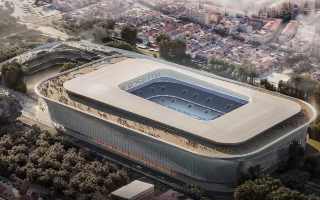
Spain: Málaga looking for the best site to build its new stadium
The City Council of Málaga has launched a public tender to select a consulting firm that will carry out a study on possible locations for the city’s new football stadium. Interested companies can submit their bids until December 5, and the chosen firm will have four months to deliver a complete report. The contract is valued at €207,410.52 including VAT.
-
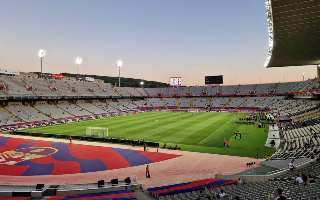
Spain: Growing doubts over the organisation of the Catalonia – Palestine match at Montjuïc
Two weeks before the historic match between Catalonia and Palestine, whose proceeds are intended to support the reconstruction of the Gaza Strip, ticket sales still have not started, and organisers warn that the match may be moved to a smaller stadium outside Barcelona.
-

World: Race to host 2029 FIFA Club World Cup begins
Qatar has officially entered the race to host the second edition of the revamped FIFA Club World Cup, joining Spain and Brazil as candidates.
-

Spain: Attendance at La Liga stadiums in the 2024/25 season
Attendance at La Liga stadiums this season once again broke all records. Most fans came to the Santiago Bernabéu, but it was Barcelona's temporary stadium that was most full. The stadiums of Espanyol, Las Palmas and Getafe were regularly empty.
-
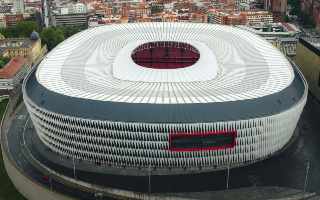
Spain: Promise delivered — San Mamés tops attendance charts
Athletic Bilbao is shining not just on the pitch but also in the stands. San Mamés has confirmed its status as the stadium with the highest attendance rate in La Liga — an impressive 90.75% of seats filled by fans.
-
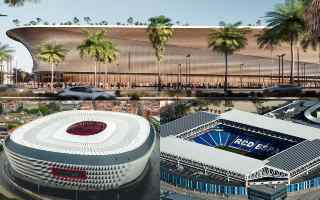
Spain: New La Rosaleda will be more expensive than San Mamés
The regional government, City Council and Province Deputation have prepared a draft agreement detailing the costs of the Nueva Rosaleda. The cost will be higher than that of the RCDE Stadium and even San Mamés, but politicians are hopeful that Málaga will join in the investment as co-owner of the stadium.
-

Spain: We’re launching in Spanish! A new YouTube channel
Some time ago, we quietly launched our new YouTube channel in Spanish – EstadiosDB. In the first full-length video, we present a ranking of the LaLiga 2024/25 stadiums, from Vallecas to Santiago Bernabéu, with an in-depth analysis of each venue.
-
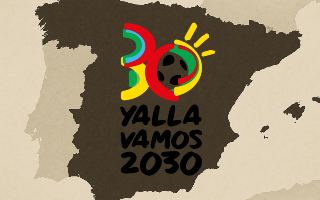
World Cup 2030: Spanish bid, shaken by insecurity, is in FIFA's hands
Shaken by the stadium evaluation affair, the Spanish bid for the 2030 World Cup faces even more challenges in the future. The pressure from Valencia, the problems of Riazor and La Rosaleda and the rising costs cause uncertainty and forecast a fight till the end, which will come with FIFA's decisions.
2024
-

FIFA: World Cup 2030 stadium evaluation. Camp Nou in the lead
Of the 23 stadiums to host the 2030 World Cup matches, as many as 14 either exist only on paper or will undergo deep redevelopment before the tournament. Nevertheless, FIFA has evaluated each of them before the Extraordinary Congress, which will already make its final decision on December 11. Also the one about the final arena.
-
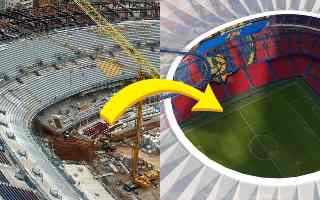
Spain: Wave of stadium upgrades sweeps through the Iberian Peninsula
In recent years, work on Spanish stadiums has not stopped, and the 2030 World Cup has provided another important impetus for the renovation of facilities. With work on the Bernabéu, Camp Nou and Balaídos already underway, 9 La Liga venues are awaiting their turn. Rosaleda, Romareda, Riazor and La Cartuja join the group as 2030 World Cup hosts.
-
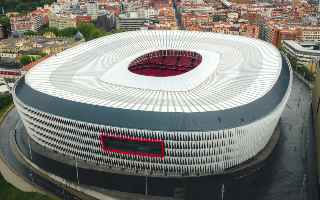
Spain: Athletic wants to turn San Mamés into a “fortress”
Athletic Club are continuing their original policy to increase attendance at San Mamés while rewarding the most loyal socios. There is a catch, however, as the whole venture presupposes that the club reaches the final of the Copa del Rey within the next two seasons.
-

Spain: San Mamés works for European cups
Athletic Club are preparing for the new season, which promises to be an exciting one for the club from the Basque Country. Los Leones have broken a 40-year streak without victory in the Copa del Rey, and with promotion to the European cups, the club's stadium is in for a little lift.
-

World Cup 2030: Spain selected 11 stadiums. Which ones are missing?
By July 31, Spain will present to FIFA the stadiums that, along with venues in Morocco and Portugal, will be part of the 2030 World Cup. The idea of proposing as many as 13 arenas was rejected, and ultimately, only eleven will be presented.
-

World Cup 2030: The race for the final (and more) enters decisive phase
Recent weeks have been tumultuous for the candidate cities, but the next few weeks will be a real storm. Of the 14 Spanish arenas aspiring to host the World Cup, only 11 will be chosen. Bernabéu, Camp Nou and Grand Stade de Casablanca are vying to host the finals, although the Moroccan megastadion exists only on paper for now.
-
Spain: Attendance at La Liga stadiums in the 2023/24 season
More than 11 million tickets were sold for Primera División matches. The record number represents another increase on previous seasons. Real Madrid and Atletico surpassed the one million spectator barrier, while Barcelona surprised by recording a mere 80% stadium fill despite playing at Montjuic. Two clubs, on the other hand, did not even exceed 70%.
2023
2022
-

World Cup 2030: Ukraine joins Spain and Portugal's bid
It is now official. Ukraine is to complete the Iberian countries' aspiration to host the 2030 FIFA World Cup. The heads of the three national federations made the announcement at a press conference at UEFA headquarters in Nyon. The selection of the 2030 World Cup host will take place at the 74th FIFA Congress in 2024.
-

Spain: Meet the 2022/23 LaLiga stadiums!
The next season of the Spanish elite starts this evening. It will be a special year for fans around the world, as Robert Lewandowski will soon make his debut at LaLiga stadiums. Therefore, we have prepared for you an overview of all twenty Spanish football arenas from the top tier of competition.
-

Spain: Valencia CF unveils renderings of Nou Mestalla
Six-time La Liga champions Valencia CF has released updated plans for their Nou Mestalla stadium. The capacity of the future venue has also been made public. It will reach 49,000, but the facility will be able to accommodate up to 70,000 fans due to the possibility of easy expansion.
 StadiumDB
StadiumDB

